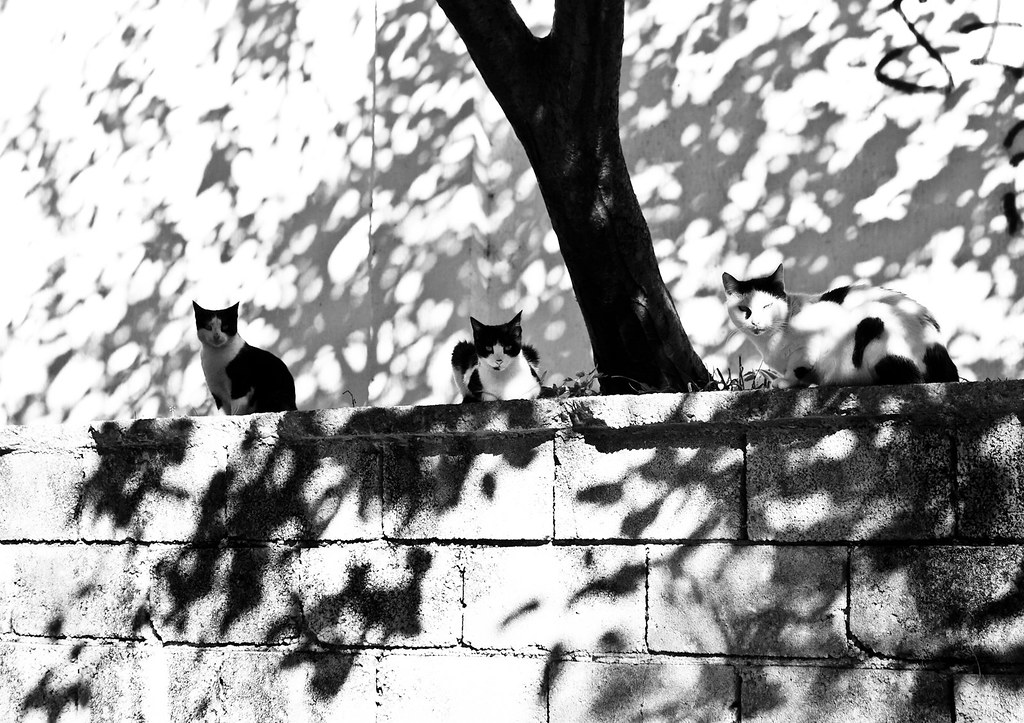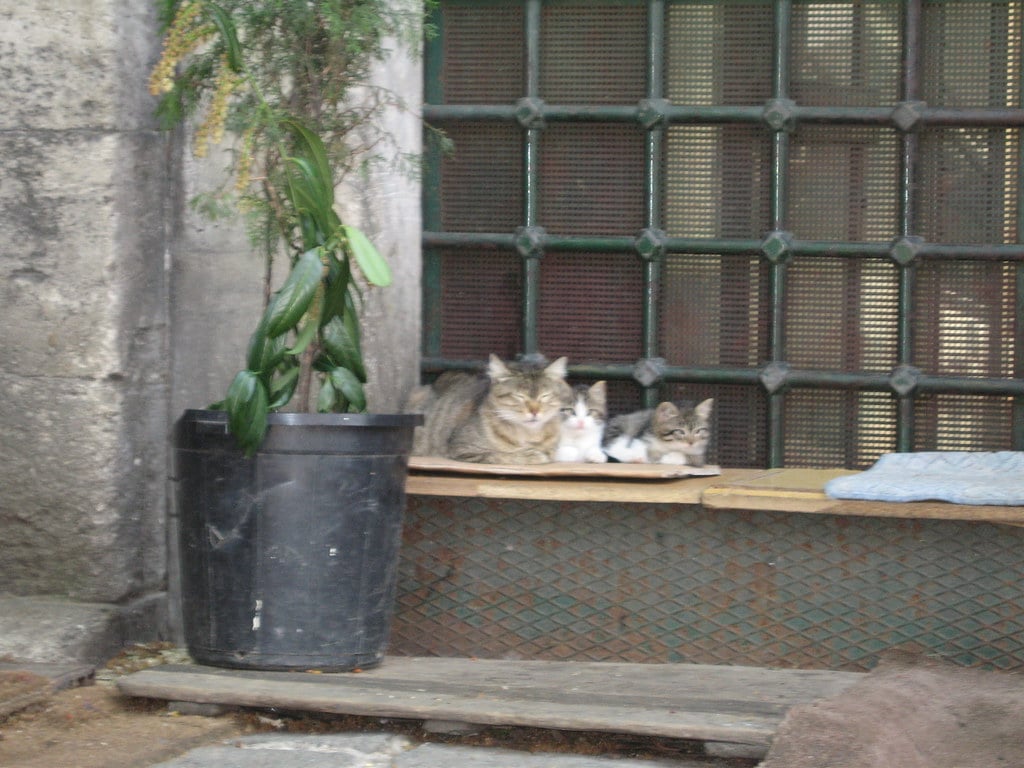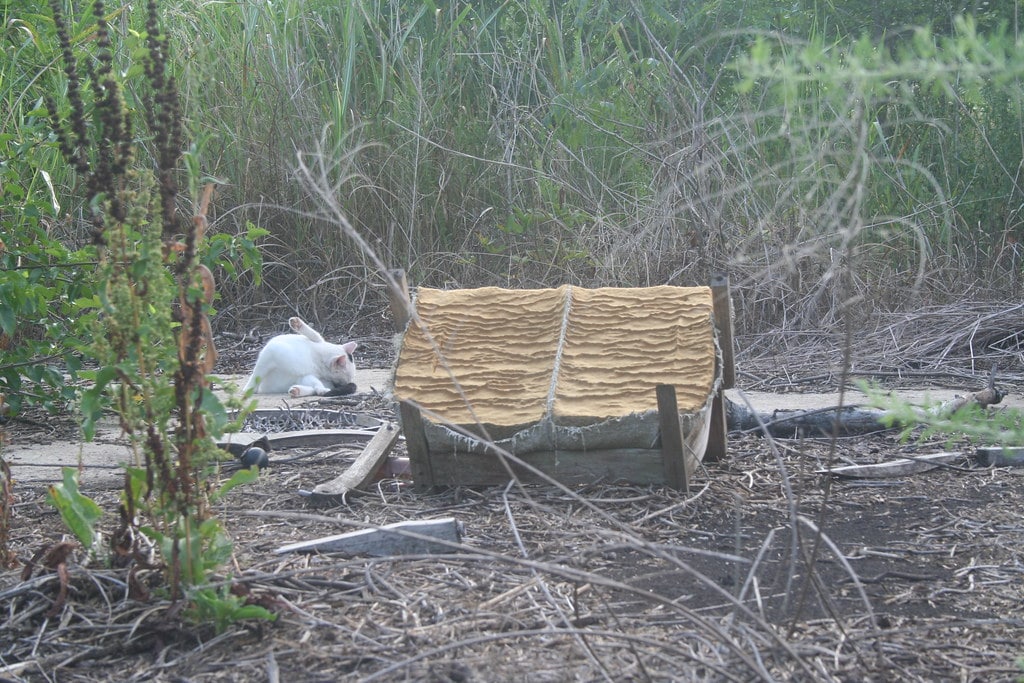More and more, people are finding ways to coexist in peace with free-roaming outdoor cats. One way to help stray cats and feral cats in your area is to build a winter cat shelter, or even an all-seasons outdoor cat shelter. It’s easier than you might think.
What Are Community Cats?

“Community Cats” is an umbrella term that encompasses both stray cats and feral cats. Strays are cats that have lived with humans, but no longer do. They may have run away, become lost, or been abandoned. Feral cats are cats who have never lived with humans.
Stray cats often live alone, and some are friendly and approachable. Many are able to become family pets again. Feral cats often live in cat colonies. They avoid people and are generally unhappy living indoors.
Why Help Community Cats?
For a long time, people viewed outdoor cats as a nuisance. Considering the nuisance behaviours associated with feral cats, it’s no surprise. Unhoused cats can be noisy, and intact males mark their territory with pungent urine. They sometimes carry parasites, as well as diseases that can transfer to humans and domestic pets.
Eradication has been the control method of choice, and in many places, it still is. But studies have shown that culling free roaming cats only makes the problem worse. A combination of TNR (trap, neuter, return) policies, safe feeding stations, and outdoor cat shelters reduces the number of outdoor cats, cuts down on nuisance behaviours, and keeps colonies healthy.
Helping community cats is good for the cats, but also for the human communities that live near them. And that’s good news for cat lovers like us.
Why Cats Need Outdoor Shelters

In temperate areas, feral cats and strays can do very well without an outdoor cat shelter. However, in areas with extreme heat, rain, or cold, an outdoor cat house can be lifesaving. It can also help people concerned with the welfare of their community cats to keep an eye on the health and wellbeing of colony members.
How and When Cats Use an Outdoor Cat Shelter
Cats use an outdoor cat shelter for three essential functions: shelter, food and water, and elimination.
Your outdoor shelter is a shelter, first. It should be water-resistant, and should provide protection from temperature extremes. Also, feral cats and some stray cats like to shelter together for company and body heat. So build your outdoor cat house with multiple cats in mind.
Providing a safe place to eat will attract cats to your outdoor cat house. Feeding them on a regular schedule will let them know that there is a reliable food source, and they’ll be more likely to stick around. Place your outdoor cat feeding station in a quiet place away from cars and foot traffic.
Make sure there is fresh water on hand at all times. This is especially important in hot climates. If your area has cold winters, take steps to ensure that the water doesn’t freeze.
Finally, feral cats are often as clean and fastidious as pet cats. If you provide and maintain an outdoor cat litter box, or several of them, free roaming cats will be less likely to do their business in your garden.
Acquiring an Outdoor Cat House
Feral cat shelters come in different sizes and designs. You can buy a commercially made outdoor shelter (we have several). You can also build your own. And you can even repurpose dog houses or other animal shelters to suit free roaming felines. There are advantages and disadvantages to all of these.
A well made commercial outdoor shelter will be weatherproof and insulated against wet and cold weather. It may have a cat flap, as well as more than one exit. Some shelters are made for a single cat, but you can find shelters made for more than one cat, as well. Outdoor cat houses come at a variety of prices and are made in a variety of materials.
DIY feral cat shelters aren’t difficult or expensive to put together. You can often source materials from your local hardware store, too. And you will have ultimate control over design and build quality.
Repurposing an existing animal shelter may be the easiest option of all.
How to Build an All-Season Outdoor Cat House

A waterproof, insulated cat house can function not only as a winter cat shelter but can protect feral cats all year round. The SPCA in British Columbia has an inexpensive, easy cleaning design for a one to two cat shelter that you can have up and ready to use in less than an hour.
You’ll Need:
- One 32 to 64 litre plastic tub with a lid
- One styrofoam cooler that fits inside
- Straw (not hay)
- Duct tape
- Box cutter
- 6-inch plate
- Marker
- Sandpaper
- Emergency blanket (optional)
How to do it:
First, using the plate as a template, mark an entrance hole on one of the short sides of the plastic tub. The entrance should only be large enough for cats to enter: six to eight inches in diameter.
Next, use your box cutter to cut the entrance hole. The edges of the hole will be rough and scratchy, so smooth them out with sandpaper, or cover them with duct tape. This will protect the cats from scratches and cuts.
Now, put a layer of straw on the bottom of the plastic tub. This layer should be about an inch deep.
Settle the styrofoam cooler on the straw inside the plastic tub.
Using the entrance hole you made as a guide, mark a hole the same size on the foam cooler. Now take the cooler out and cut the hole.
Place the cooler back inside the plastic tub and add a layer of straw insulation between the walls of the tub and the outside of the cooler. You could also wrap the cooler in an emergency blanket.
Add straw to the inside of the cooler. It’s important to use straw, and not hay, as hay will trap any moisture that the cats bring in from the outside, as well as the moisture from their breath. This can result in a cold, wet shelter, which is exactly the opposite of what you want.
Turn the cooler’s lid upside down and duct tape it onto the top of the cooler. Layer more straw on top then put the lid onto the plastic tub.
You can watch the entire process in the video below:
If you’re not wild about this design, Alley Cat Allies has a gallery of different DIY designs for you to check out.
Alternatively, you can check the classifieds and neighbourhood websites for used dog shelters, which can be easily retrofitted to fit a cat or two. The most important alteration will be to add a cat flap, or to reduce the size of the entrance so that only cats can get inside.
Essential Features for an Outdoor Cat Shelter

Now that you have your weather resistant cat house, it’s time to make it a home. Here are some essentials for inside your cat house.
Bedding
Dry straw makes the best bedding. It neither contains nor absorbs moisture, and so can keep the inside of the shelter warm and dry. You can use straw to insulate around the shelter and inside as well.
Avoid blankets and towels, as they, too, trap moisture.
Emergency Blanket
A mylar emergency blanket (or “space blanket”) can provide extra insulation around the outside of the shelter.
Cool Pad
If the summer months are hot in your area, consider adding a cool pad to your cat house. Our Chillax cool pad requires no electricity or other power; it’s activated by a cat’s weight. Importantly, it has a polyester cover that wipes clean and doesn’t trap moisture.
Heating Pad
You might consider adding a heat pad to your cat house to help the cats to stay warm. We sell a self-heating pad that requires no electricity or other power source. Rather, it reflects an animal’s body heat back at it.
The disadvantage of many heating pads is that they’re covered in fabric and can trap moisture. But with our self-heating pad, you can remove the fleece cover and replace it with something more moisture resistant. You could even use waterproof polyester to craft a simple covering of your own.
Food and Water
Many DIY cat shelter designs are snug — by design; that’s how a cat likes it. But that means no room inside the shelter for food and water.
That’s all right. It’s easy to set up a feeding station nearby. This short video from Alley Cat Allies shows you how.
Hint: buy an extra 32 to 64 litre plastic tub when you’re gathering materials for your DIY shelter.
Litter Box
Consider providing a litter box or two for the ferals in your community. This will help to keep them clean, and will reduce the chances of them defecating in your garden.
One word of advice, though: don’t use litter box liners. According to Lucky Ferals, many strays will take a litterbox liner as a destruction challenge.
Are You Ready to Help Your Free Roaming Felines?
Humans and free roaming felines can coexist peacefully. In fact, it’s better for everyone if we try. Providing a feeding station, community litter boxes, and a cat house can be a great place to start.
Do you have an outdoor cat shelter? Do you have any advice for our readers? We’d love to hear it!
















